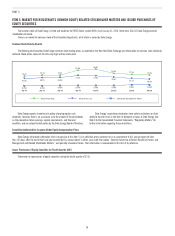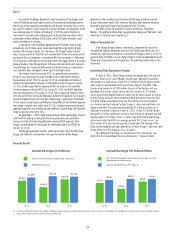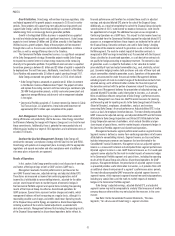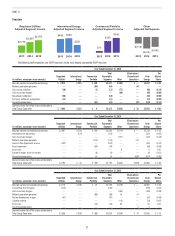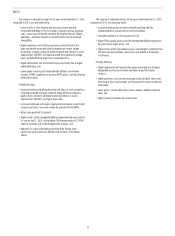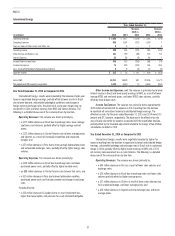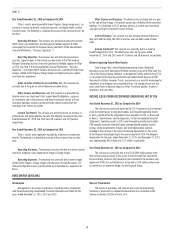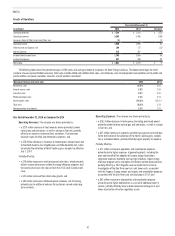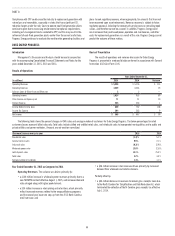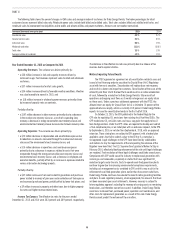Duke Energy 2015 Annual Report Download - page 56
Download and view the complete annual report
Please find page 56 of the 2015 Duke Energy annual report below. You can navigate through the pages in the report by either clicking on the pages listed below, or by using the keyword search tool below to find specific information within the annual report.
36
PART II
An order from regulatory authorities disallowing recovery of costs related
to closure of ash impoundments could have an adverse impact on Regulated
Utilities’ financial position, results of operations and cash flows. See Notes
4 and 9 to the Consolidated Financial Statements, “Regulatory Matters” and
“Asset Retirement Obligations,” respectively, for additional information.
In 2013, a Federal Energy Regulatory Commission (FERC) Administrative
Law Judge (ALJ) issued an initial decision that Duke Energy is responsible
for costs associated with Multi Value Projects (MVP), a type of Transmission
Expansion Planning (MTEP) cost, approved by MISO prior to the date of Duke
Energy’s withdrawal. On October 29, 2015, the FERC issued an order reversing
the ALJ’s decision. FERC ruled that Duke Energy has no liability for MVP costs
after its withdrawal from MISO. On November 30, 2015, MISO filed with the
FERC a request for rehearing. MISO may appeal the FERC’s decision if its
request for rehearing is denied. If Duke Energy is deemed responsible for these
costs, and if the regulatory commissions disallow recovery of these costs,
there would be an adverse impact to Regulated Utilities’ financial position,
results of operations and cash flows. See Note 4 to the Consolidated Financial
Statements, “Regulatory Matters,” for additional information.
The FPSC approved an agreement on all securitization-related issues and
issued a final financing order to securitize the Crystal River Unit 3 Regulatory
asset with low-cost securities. Securitization will replace base rate recovery
and result in a lower rate impact to customers. Securitization of the costs of the
retired Crystal River Unit 3 Nuclear Plant would result in an initial acceleration
of cash, followed by a reduction to Regulated Utilities’ future results of
operations and ongoing cash flows as it would no longer earn an equity return
on these costs. Under a previous settlement agreement with the FPSC, the
allowed return on equity for Crystal River Unit 3 is limited to 70 percent of the
approved return on equity, which is currently 10.5 percent. Regulated Utilities
expects to issue the securitization bonds in the first half of 2016.
In September 2015, Duke Energy Indiana entered into a settlement
agreement with multiple parties that will resolve all disputes, claims and issues
from the IURC proceedings regarding the Edwardsport IGCC generating facility.
In January 2016, additional parties joined a revised settlement. Pursuant to
the terms of the agreement, Regulated Utilities recognized an impairment
and related charges of $93 million. Additionally, the agreement stipulates
the recovery of the remaining regulatory asset over an eight-year period and
confirms the conclusion that the in-service date for accounting and ratemaking
purposes will remain June 7, 2013. The settlement agreement will also impose a
cost cap for recoverable operations and maintenance retail costs of $73 million
in 2016 and $77 million in 2017 as well as a cost cap for ongoing capital
expenditures through 2017. As part of the settlement, Duke Energy Indiana
committed to cease burning coal at Gallagher Station Units 2 and 4 by the end
of 2022. The settlement is subject to IURC approval and if approved would
resolve and close a number of outstanding issues pending before the IURC
related to post commercial operating performance and recovery of ongoing
operating and capital costs at Edwardsport. If the settlement is not approved,
outstanding issues before the IURC related to Edwardsport would resume,
the ultimate resolution of which could have an adverse impact on Regulated
Utilities’ financial position, results of operations and cash flows. In addition,
the inability to manage operating and capital costs under caps imposed under
the settlement could have an adverse impact on Regulated Utilities’ financial
position, results of operations and cash flows. See Note 4 to the Consolidated
Financial Statements, “Regulatory Matters,” for additional information.
On October 23, 2015, the EPA published in the Federal Register the
CPP rule for regulating CO2 emissions from existing fossil fuel-fired EGUs. The
CPP establishes CO2 emission rates and mass cap goals that apply to fossil
fuel-fired generation. Under the CPP, states are required to develop and submit
a final compliance plan, or an initial plan with an extension request, to the EPA
by September 6, 2016, or no later than September 6, 2018, with an approved
extension. These state plans are subject to EPA approval, with a federal plan
applied to states that fail to submit a plan to the EPA or if a state plan is
not approved. Legal challenges to the CPP have been filed by stakeholders
and motions to stay the requirements of the rule pending the outcome of the
litigation have been filed. The U.S. Supreme Court granted a Motion to Stay in
February 2016, effectively blocking enforcement of the rule until legal challenges
are resolved. Final resolution of these legal challenges could take several years.
Compliance with CPP could cause the industry to replace coal generation with
natural gas and renewables, especially in states that have significant CO2
reduction targets under the rule. Costs to operate coal-fired generation plants
continue to grow due to increasing environmental compliance requirements,
including ash management costs unrelated to CPP, and this may result in the
retirement of coal-fired generation plants earlier than the current useful lives.
Regulated Utilities continues to evaluate the need to retire generating facilities
and plans to seek regulatory recovery, where appropriate, for amounts that have
not been recovered upon asset retirements. However, recovery is subject to
future regulatory approval, including the recovery of carrying costs on remaining
book values, and therefore cannot be assured. In addition, Regulated Utilities
could incur increased fuel, purchased power, operation and maintenance, and
other costs for replacement generation as a result of this rule. Regulated Utilities
cannot predict the outcome of these matters.


